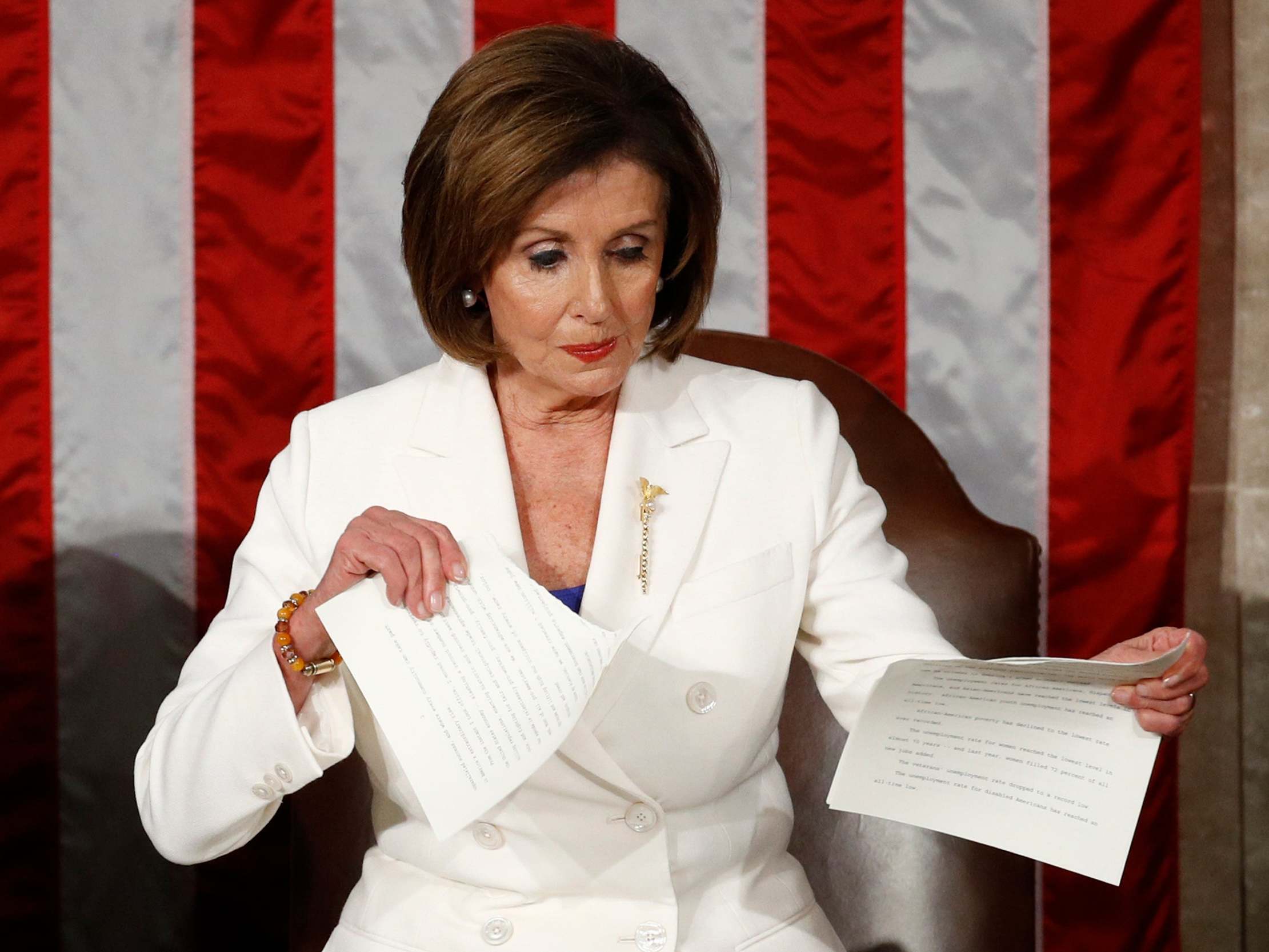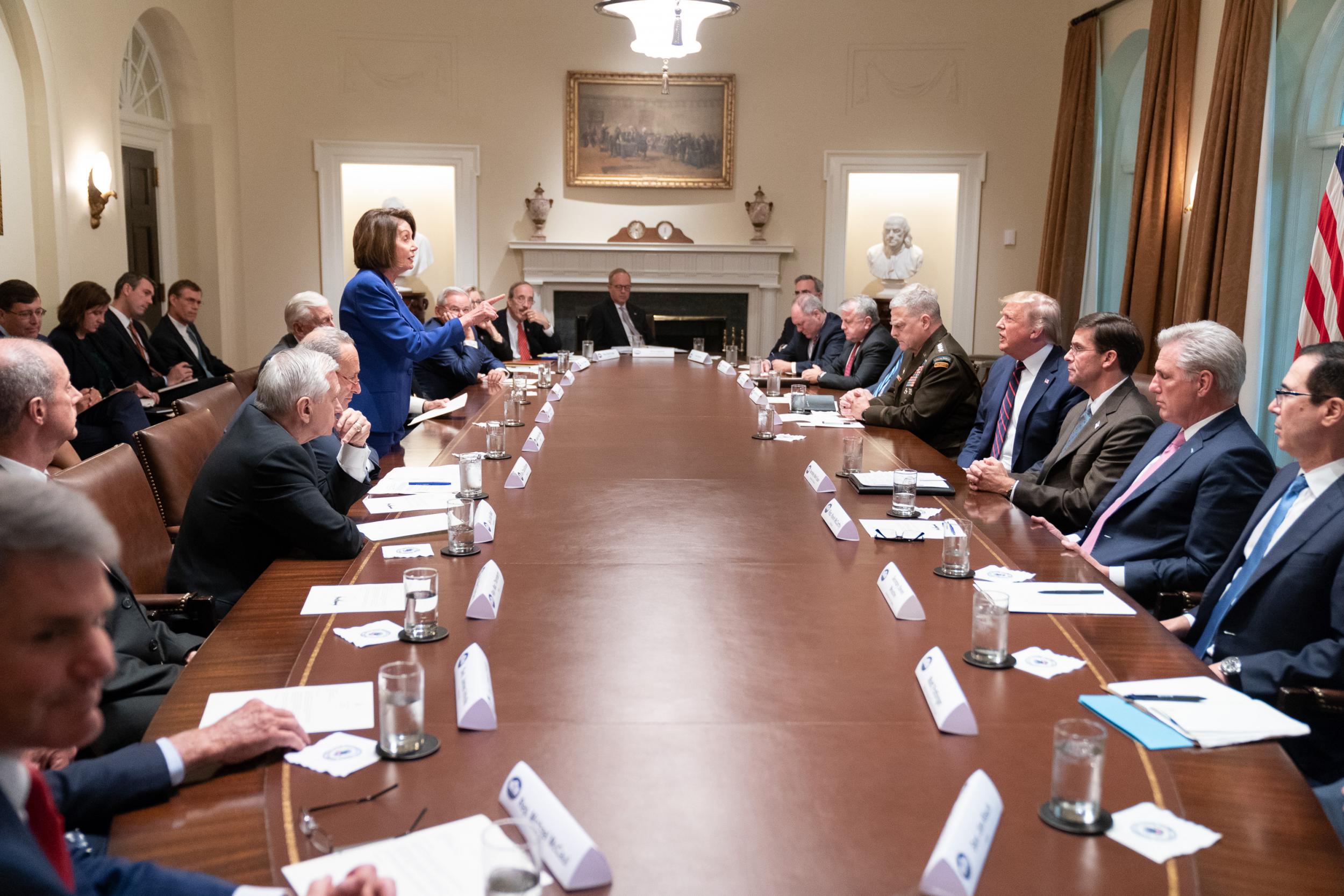Trump and Pelosi’s desperate fight for the hearts and minds of the future
From tearing up speeches to spinning ever more fabulous yarns, the speaker and the president are locked in a titanic struggle for the judgement of posterity. Phil Thomas explains


In their new book on the Trump administration, A Very Stable Genius, the reporters Philip Rucker and Carol Leonnig describe the first encounter between the newly elected president’s inner circle and the leaders of congress. Nancy Pelosi, the top Democrat in the House, was an object of particular fascination to the incoming team.
The Washington Post journalists relate that Steve Bannon, Trump’s chief strategist at the time, saw her as “Katharine Hepburn from The Lion in Winter – who looks up and down the table and thinks to herself, ‘These men are all clowns,’ and plots her return to power”.
In the film, Hepburn played Eleanor of Aquitaine, wife of the English king Henry II and, in her own right, one of the most powerful figures in medieval Europe. It’s appropriate that Bannon saw Pelosi in historical terms. The House Speaker appears to have an acute sense of how the all-consuming rough and tumble of everyday politics will gradually coalesce into the smooth narrative of history.

And that provides a clue as to why she tore up her copy of the State of the Union address.
The tensions had been there from the start: a day before he was due to be acquitted by Republican allies in the Senate on the impeachment charges Pelosi herself had launched against him from the House, Trump refused to shake her outstretched hand. She in turn neglected to give him the traditional welcome in her opening comments.
As Trump came to the end of a speech in which he had made a series of tall claims about the economy – awarded the far-right radio host Rush Limbaugh the presidential Medal of Freedom, America’s highest civilian honour; pledged to ban what he called “late-term abortions”; and denounced socialism – Pelosi stood up and ostentatiously ripped up her copy. The gesture was startling even in an era where several news cycles seem to unspool in the space of a day.
It raised instant questions from all sides. Was it cynically pre-planned, as photos of light tear-marks before the actual ripping suggested? Was it an uncharacteristic loss of temper from someone normally so meticulous in observing decorum? Was she foolishly playing into Republicans’ hands by allowing them to paint her as disrespectful and out of control?
There’s another possibility: that she was deliberately sending a coded message to the citizens of the future. Those torn pieces of paper are a tattered time capsule, addressed to millions of Americans yet to be born – and representing an urgent bid for their hearts and minds.

After all, what will happen to the ripped pieces of A4? It’s likely that some at least will end up on display in the Library of Congress and other museums around the country, perhaps even abroad. Unlike more mundane political memorabilia – Millard Fillmore’s pipe or Frances Perkins’s umbrella – Pelosi’s shredded paper is super-charged with historical resonance.
Future students coming to it for the first time will be forced to ask: why would someone tear up a speech? The answer contains the very gist of the Democrats’ accusations against Trump, vacuum sealed into what will look like a pop art experiment: the lies, the incompetence, the viciousness, the lack of respect for democratic norms. One evening long from now, students of the future will muse, desperate times must have called for desperate measures.
Of course, there should still be history books and documentaries to help guide our descendants through the tumultuous times we’re just about surviving. But let’s not underestimate the power of props or the enduring appeal of political theatre (Oliver Cromwell seizing the mace sets the scene far more vividly than hours spent poring over 17th-century speeches ever could).
Pelosi has form on this. Signing the articles of impeachment against Trump in December she made sure to use a number of pens, immediately investing each with historical significance.
In October a photograph emerged from a White House meeting, held to discuss Trump’s abandonment of the Kurds in Syria, that the Speaker was about to storm out of. It shows her standing alone among seated men, her finger raised to make a point, as Trump sits across from her, seemingly mid-snarl, while his generals and cabinet members stare silently down at the table, brows furrowed and hands clasped, perhaps embarrassed by their commander-in-chief or their own acquiescence.
The daughter of a long-time mayor of Baltimore, and someone who was photographed as a 20-year-old with JFK before her own political career began, was always going to have an eye on the long game
Trump tweeted the picture, captioning it “Nervous Nancy’s unhinged meltdown!” It didn’t seem to occur to him that it made her look strong, courageous, resolute – the only person willing to stand up and be counted – and made him seem angry and immature. She quickly made it the banner picture on her Twitter account. It’s hard not to think she knew exactly what she was doing when she got to her feet.
So tearing up her copy of the State of the Union speech may have been a spur of the moment decision. It may have been prompted by a surge of emotion. It may even – as some have suggested – have been a defensive reaction to an unusually rousing speech by the often rambling president. But it was certainly in character and part of an established thought process. The daughter of a long-time mayor of Baltimore, and someone who was photographed as a 20-year-old with JFK before her own political career began, was always going to have an eye on the long game.
Trump too is trying to shape history, albeit in a less sophisticated fashion. He may not know what happened at Pearl Harbour, and he might not have read the constitution, but he understands as instinctively as Pelosi that history is written by the winners.
The Trump strategy is simple: bludgeon home a message about his own brilliant achievements and the miserable failure of others until people’s mental resistance is worn down. Keep hammering away until his “alternative facts” begin to worm their way into the public consciousness and, thereafter, into the tapestry of history.
In the event of some cataclysmic environmental disaster that wipes out all official records before Trump’s election, future archaeologists will be left with a pretty clear picture of the past. Following the social and economic “carnage” wrought by the incompetence of a corrupt and lazy Kenyan imam named Barack Hussein Obama, Donald J Trump won the greatest victory in American history (despite millions of illegal votes and a deep-state conspiracy to stop him) before shepherding the economy to unheard of heights, all the while making the US respected around the world for the first time – and even reinstating Christmas!
None of it’s true of course, but who knows what myths from our era will persist. Did Marie Antoinette really say “Let them eat cake”? Did Nero fiddle while Rome burned? No. But we’re generally not too fussed about believing they did.
Denigrating his predecessor is almost as important as blowing his own trumpet. Trump has invoked Obama’s name thousands of times, sometimes hundreds of times in the space of a month, always in a negative context. If, as the 45th president claims, there is such a thing as Trump Derangement Syndrome – an obsession with doing him down that supposedly afflicts Democrats and the media – then perhaps there is also be such a thing as Obama Derangement Syndrome. No guesses as to who the super-spreader of that particular virus might be.

Aggressively attacking differing narratives as “fake news” is also an important part of the battle. And for someone who supposedly knows little or no history, Trump talks about it constantly. The Iran deal (Obama’s, of course) was “the worst deal in history”. So too was the North American Free Trade Deal. (Whether one worst was worse than the other worst is yet to be resolved.)
Trump’s achievements, promises and threats are often framed in history-defying terms, as being “the likes of which the world has never seen” (CNN has helpfully compiled some of these “world-has-never-seen” global firsts: “a historic movement”; “American prosperity”; “fire and fury”; “regulations being eliminated”; “immigration control”; “rebuilding the military”; “people noticing”; and “nuclear”.)
He has repeatedly claimed that no president in history has achieved as much as he has in his first three years and compared himself approvingly with George Washington, Abraham Lincoln and – apparently the president he most identifies with, as a fellow rough-hewn DC outsider – Andrew Jackson.
Even if he gets his details wrong from time to time (General Washington did not, in fact, seize Britain’s airfields during the War of Independence) the president has the judgement of the ages firmly in mind. It may not have been lost on him that several lists compiled by academics of the best and worst of America’s 45 presidents have placed him at the very bottom, below traditional whipping boys like Warren Harding, James Buchanan and fellow impeachee Andrew Johnson.
Having managed to impeach a president, as well as taking prominent roles in passing Obamacare and other legislation, she can perhaps allow herself a wry smile at that
Appropriately, given their rival bids for supremacy over the narrative of the future, Trump has dubbed Pelosi “maybe the worst Speaker in the history of our country”. Having managed to impeach a president – him – (only the third Speaker to achieve such a prize) as well as taking prominent roles in passing Obamacare and other legislation, she can perhaps allow herself a wry smile at that.
Back in that 2017 meeting described by Leonnig and Rucker, Pelosi calls out Trump for lying about having won the popular vote. Watching her coolly challenge the president, Bannon whispers to a colleague: “She’s going to get us. Total assassin. She’s an assassin.”
Trump will keep bashing away at the blunt narrative he hopes will see him immortalised as, at the very least, a new Ronald Reagan – divisive in his own time perhaps, but the object of wistful bipartisan adoration three decades on.
As long she keeps leaving a trail of torn pieces of paper like breadcrumbs through the forest, however, Pelosi might be running rings round him for centuries to come.
Join our commenting forum
Join thought-provoking conversations, follow other Independent readers and see their replies
Comments